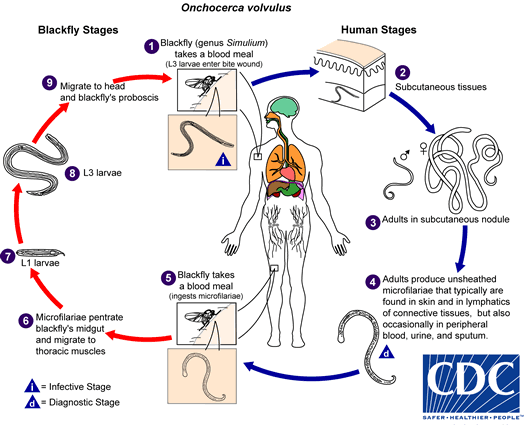Biology
Casual Agents
Onchocerciasis is caused by nematodes (roundworms) that inhabit subcutaneous tissues.
Life Cycle

During a blood meal, an infected blackfly (genus Simulium) introduces third-stage filarial larvae onto the skin of the human host, where they penetrate into the bite wound  . In subcutaneous tissues the larvae
. In subcutaneous tissues the larvae  develop into adult filariae, which commonly reside in nodules in subcutaneous connective tissues
develop into adult filariae, which commonly reside in nodules in subcutaneous connective tissues  . Adults can live in the nodules for approximately 15 years. Some nodules may contain numerous male and female worms. Females measure 33 to 50 cm in length and 270 to 400 μm in diameter, while males measure 19 to 42 mm by 130 to 210 μm. In the subcutaneous nodules, the female worms are capable of producing microfilariae for approximately 9 years. The microfilariae, measuring 220 to 360 µm by 5 to 9 µm and unsheathed, have a life span that may reach 2 years. They are occasionally found in peripheral blood, urine, and sputum but are typically found in the skin and in the lymphatics of connective tissues
. Adults can live in the nodules for approximately 15 years. Some nodules may contain numerous male and female worms. Females measure 33 to 50 cm in length and 270 to 400 μm in diameter, while males measure 19 to 42 mm by 130 to 210 μm. In the subcutaneous nodules, the female worms are capable of producing microfilariae for approximately 9 years. The microfilariae, measuring 220 to 360 µm by 5 to 9 µm and unsheathed, have a life span that may reach 2 years. They are occasionally found in peripheral blood, urine, and sputum but are typically found in the skin and in the lymphatics of connective tissues  . A blackfly ingests the microfilariae during a blood meal
. A blackfly ingests the microfilariae during a blood meal  . After ingestion, the microfilariae migrate from the blackfly's midgut through the hemocoel to the thoracic muscles
. After ingestion, the microfilariae migrate from the blackfly's midgut through the hemocoel to the thoracic muscles  . There the microfilariae develop into first-stage larvae
. There the microfilariae develop into first-stage larvae  and subsequently into third-stage infective larvae
and subsequently into third-stage infective larvae  . The third-stage infective larvae migrate to the blackfly's proboscis
. The third-stage infective larvae migrate to the blackfly's proboscis  and can infect another human when the fly takes a blood meal
and can infect another human when the fly takes a blood meal  .
.
Life cycle image and information courtesy of DPDx.
- Page last reviewed: May 21, 2013
- Page last updated: May 21, 2013
- Content source:


 ShareCompartir
ShareCompartir